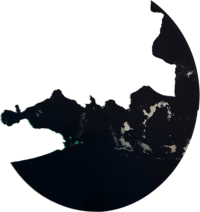The artist as sensory seismograph is neither detached observer nor expressive performer. Instead, they are a responsive instrument — tuned to the subtle shifts in atmosphere, emotion, and environment. Like a seismograph detects tremors beneath the surface of the earth, the artist registers invisible vibrations: the weight of air before a storm, the emotional residue of a place, the pressure of time pressing through the body.
This kind of artmaking begins with attentiveness. It requires immersion — not in spectacle, but in sensation. The artist absorbs the qualities of a site, not to document it, but to be moved by it. In this model, perception is not passive; it is active, porous, and reciprocal. The artist receives — temperature, wind, tension, silence — and responds through gesture, material, or sound.
What emerges from this exchange is not representation, but trace: a residue of presence. A poured ink line carries the memory of gravity. A piano note holds the imprint of a passing feeling. The work becomes evidence — not of an idea, but of a lived moment.
To be a sensory seismograph is to trust that meaning arises through contact. It is to honor what cannot be fully grasped, but only sensed. In this way, the artist translates presence into form — and invites the viewer to feel, not just to see.
-Markus Kager
May 8, 2025
